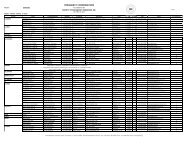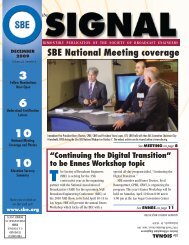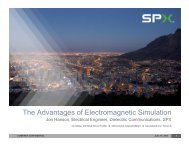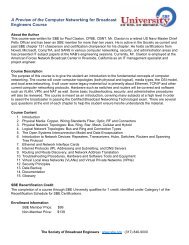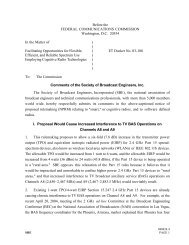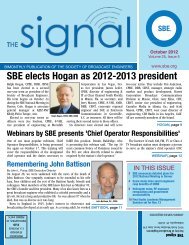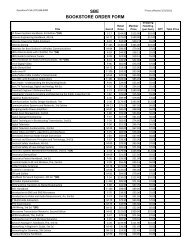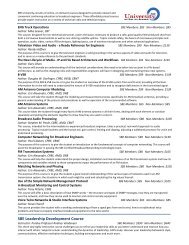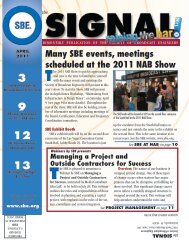Thomas re-elected SBE President - Society of Broadcast Engineers
Thomas re-elected SBE President - Society of Broadcast Engineers
Thomas re-elected SBE President - Society of Broadcast Engineers
You also want an ePaper? Increase the reach of your titles
YUMPU automatically turns print PDFs into web optimized ePapers that Google loves.
DTV Transport St<strong>re</strong>am Verification<br />
BY Jerry Whitaker<br />
VP Standards Development, ATSC<br />
he Advanced Television Systems<br />
Committee (ATSC) has published<br />
a Recommended Practice (RP) on<br />
digital television (DTV) transport st<strong>re</strong>am<br />
verification. An ATSC RP is a document<br />
that states specifications or criteria within<br />
advanced television systems that a<strong>re</strong> not<br />
strictly necessary for effective implementation<br />
and interoperability, but that a<strong>re</strong><br />
thought to be advisable and may improve<br />
the efficiency <strong>of</strong> implementation or <strong>re</strong>duce<br />
the probability <strong>of</strong> implementation errors.<br />
An ATSC Recommended Practice may also<br />
specify a p<strong>re</strong>fer<strong>re</strong>d methodology for implementation<br />
and operation, and may <strong>re</strong>commend<br />
a choice from among alternatives.<br />
Document A/78, “ATSC Recommended<br />
Practice: Transport St<strong>re</strong>am Verification,”<br />
outlines a common methodology for<br />
describing transport st<strong>re</strong>am conformance<br />
criteria for digital television. This document<br />
explicitly describes the elements and parameters<br />
<strong>of</strong> ATSC Standards A/53 and A/65<br />
that should be verified in a transport st<strong>re</strong>am<br />
for it to be conside<strong>re</strong>d a proper emission.<br />
This document does not cover RF, captioning,<br />
or elementary st<strong>re</strong>ams.<br />
the Program Map Table (PMT).<br />
l PSIP errors. The Program and<br />
System Information Protocol (PSIP) is the<br />
glue that holds the DTV signal together.<br />
Although PSIP is a voluntary standard<br />
<strong>of</strong> the ATSC (document A/65), it is—in<br />
fact—a <strong>re</strong>qui<strong>re</strong>ment in terms <strong>of</strong> actual<br />
<strong>re</strong>al-world operation. The purpose <strong>of</strong> PSIP<br />
is to describe the information at the system<br />
and event levels, and to enable an abstract<br />
<strong>of</strong> the collection <strong>of</strong> programs (a virtual<br />
channel).<br />
l Timing Model and Buffering<br />
errors. Timing is the key to the MPEG-2<br />
encoding and decoding processes. MPEG-2<br />
defines a model for the system timing,<br />
adhe<strong>re</strong>nce to which allows independent<br />
design <strong>of</strong> encoders and decoders that can<br />
interoperate. An MPEG-2 decoder’s 27 MHz<br />
<strong>re</strong>fe<strong>re</strong>nce clock needs to be synchronized<br />
with the equipment that is c<strong>re</strong>ating the<br />
encoded st<strong>re</strong>am.<br />
l Consistency errors. Befo<strong>re</strong> a<br />
<strong>re</strong>ceiver can decode a transport st<strong>re</strong>am,<br />
it must identify the <strong>re</strong>lationship between<br />
components in the st<strong>re</strong>am. Some components<br />
contain audio and video (elementary<br />
st<strong>re</strong>ams), and other components contain<br />
information describing the <strong>re</strong>lationship<br />
between them (metadata). The <strong>re</strong>ceiver<br />
uses metadata to identify each component,<br />
determine its function and select an<br />
appropriate set <strong>of</strong> components when the<br />
user selects a virtual channel for decoding.<br />
Conflicts and problems within the structu<strong>re</strong><br />
<strong>of</strong> metadata a<strong>re</strong> called ‘consistency errors.’<br />
Consistency errors can <strong>re</strong>sult in broken<br />
decoding, missing system components<br />
(such as closed captioning), and/or missing<br />
program guide information.<br />
l General errors. These errors cover<br />
a variety <strong>of</strong> types <strong>of</strong> problems, typically<br />
transport-<strong>re</strong>lated.<br />
Each error type is provided with a defined<br />
“error severity”, as detailed below:<br />
l Transport St<strong>re</strong>am Off-Air: The<br />
station is effectively <strong>of</strong>f-air as the transport<br />
st<strong>re</strong>am errors a<strong>re</strong> seve<strong>re</strong> enough<br />
damaged beyond utility. Receivers will not<br />
be able to tune and decode anything within<br />
the broadcast. The complete or <strong>re</strong>peated<br />
absence <strong>of</strong> sync bytes would be an example<br />
<strong>of</strong> this level <strong>of</strong> error.<br />
l Program Off-Air: A main service<br />
(virtual channel) is flawed to the point that<br />
that service is effectively <strong>of</strong>f-air for conformant/<strong>re</strong>asonable<br />
<strong>re</strong>ceiver designs. This<br />
could involve all <strong>of</strong> the program elements<br />
being improperly constructed or incor<strong>re</strong>ct/missing<br />
signaling about elements. The<br />
absence <strong>of</strong> an entry in the Virtual Channel<br />
Table (VCT) for a service would be an<br />
example <strong>of</strong> this type <strong>of</strong> error.<br />
l Component Missing: One or the<br />
program components that is signaled by<br />
PSIP or the Program Map Table (PMT) as<br />
p<strong>re</strong>sent is either not p<strong>re</strong>sent or cannot be<br />
found and decoded. One example would<br />
be a mismatch between the video Program<br />
ID (PID) signaled in the Service Location<br />
Descriptor (SLD) and the actual PID used<br />
for the video elementary st<strong>re</strong>am.<br />
l Quality <strong>of</strong> Service: Parameters a<strong>re</strong><br />
out <strong>of</strong> specification by such a margin that<br />
a significant fraction <strong>of</strong> the <strong>re</strong>ceivers can<br />
be expected to produce flawed outputs. In<br />
many cases, the broadcast is viewable, but<br />
may exhibit some form <strong>of</strong> degradation to<br />
the viewer. An example might be the Master<br />
Guide Table (MGT) cycle time being somewhat<br />
larger than the specification, which<br />
would cause slower than normal channelchange<br />
tuning.<br />
l Technically Non-Conformant:<br />
Violates the letter <strong>of</strong> the standard, but in<br />
practice will have little effect on the viewing<br />
experience. Errors <strong>of</strong> this type should be<br />
cor<strong>re</strong>cted, but do not have the urgency <strong>of</strong><br />
higher severity errors. An example might<br />
be a single instance <strong>of</strong> a 152 ms MGT cycle<br />
time (with the <strong>re</strong>mainder <strong>of</strong> the MGTs coming<br />
at less than 150 ms intervals).<br />
The distinctions between these error classifications<br />
a<strong>re</strong> important and drove work<br />
on the RP. After some study it became<br />
clear that a laye<strong>re</strong>d approach that indi-<br />
About the Document<br />
While ATSC Standards strictly define the<br />
contents and characteristics <strong>of</strong> the DTV<br />
emission transport st<strong>re</strong>am, the<strong>re</strong> may be a<br />
number <strong>of</strong> interactions and inter<strong>re</strong>lationships<br />
amongst various components. Successful<br />
tuning and display <strong>of</strong> programs can<br />
be ensu<strong>re</strong>d if the transport st<strong>re</strong>am adhe<strong>re</strong>s<br />
to the applicable specifications.<br />
This Recommended Practice identifies<br />
transport st<strong>re</strong>am issues by type, dividing errors<br />
into the general following categories:<br />
l PSI errors. An ATSC conformant<br />
transport st<strong>re</strong>am is also <strong>re</strong>qui<strong>re</strong>d to be<br />
MPEG-2 conformant. The<strong>re</strong>fo<strong>re</strong>, an ATSC<br />
transport st<strong>re</strong>am must include the two<br />
mandatory Program Specific Information<br />
(PSI) tables. These two tables a<strong>re</strong> known as<br />
the Program Association Table (PAT) and<br />
10<br />
that transport level logical constructs a<strong>re</strong> cated the severity <strong>of</strong> the error would be<br />
the SIGNAL<br />
?



